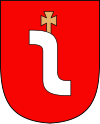Lesko
| Lesko | ||
|---|---|---|

|
||
|
||
| Coordinates: 49°28′28″N 22°19′44″E / 49.47444°N 22.32889°E | ||
| Country |
|
|
| Voivodeship |
|
|
| County | Lesko County | |
| Gmina | Gmina Lesko | |
| Established | 14th century | |
| Town rights | before 1470 | |
| Government | ||
| • Mayor | Barbara Jankiewicz | |
| Area | ||
| • Total | 15.09 km2 (5.83 sq mi) | |
| Population (2006) | ||
| • Total | 5,864 | |
| • Density | 390/km2 (1,000/sq mi) | |
| Time zone | CET (UTC+1) | |
| • Summer (DST) | CEST (UTC+2) | |
| Postal code | 38-600 | |
| Area code(s) | +48 13 | |
| Car plates | RLS | |
| Website | http://www.lesko.pl | |
Lesko [ˈlɛskɔ] (or Lisko until 1926; Latin: Lescow, alias Olesco Lescovium; Yiddish: לינסק-Linsk; Ukrainian: Лі́сько) is a town in south-eastern Poland with a population of 5,755 (02.06.2009). situated in the Bieszczady mountains. It is located in the heartland of the Doły (Pits), and its average altitude is 390 metres (1,280 feet) above sea level, although there are some hills located within the confines of the city. Since 2002 it has been the capital of Lesko County.
Lesko is situated in the Subcarpathian Voivodeship (since 1999); previously it was in Krosno Voivodeship (1975–1998).
gothic parish church built in 1539 by the Kmita family and small street in Lesko
Gothic Parish church of the Visitation of the Most Blessed Virgin Mary
Parish church
Franciszek Pulaski's cavalry captain - Kazimierz Pulaski's cousin memorial plaque inside parish church
Kmita's castle
Lesko was probably founded in the fourteenth century; records first mention it in 1436. It was granted its town charter in approximately 1469, when it was owned by the Kmita family. In the seventeenth century, the town was quite an important centre of trade and craftsmanship, with approximately 1,500 inhabitants. Its heyday ended in 1704, when it was looted by the Swedish troops during the Great Northern War.
In 1772, following the First Partition of Poland, the town was located in the Austrian Empire (from 1867 Austria-Hungary) until Poland regained its independence in 1918. In 1872 a railway line passing just 3 kilometres (2 miles) north of the town was built.
...
Wikipedia


